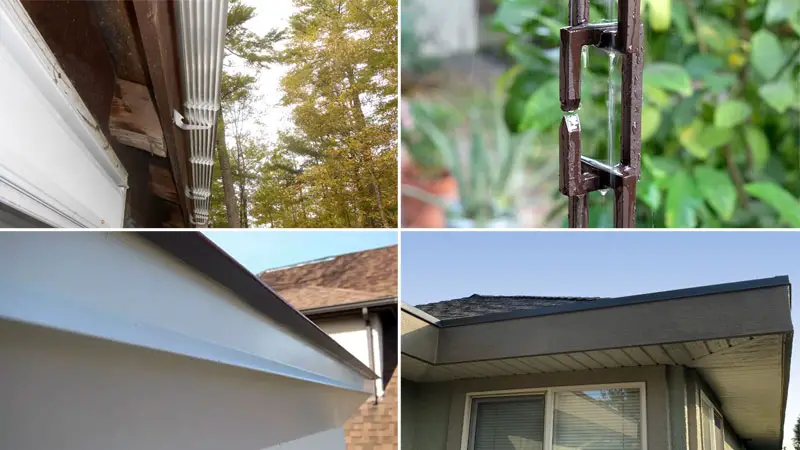Updated on January 3, 2022
While many people choose to rely on regular rain gutters for redirecting water and protecting their homes from relevant damage, they are not ideal for everyone. Regardless of whether you prefer something more aesthetically pleasing or simply something with better functionality, other options exist for you.
Here you will find several high-quality alternatives to gutters for your house.
See Also: 29 Types of Roofs
Alternatives to Gutters
1. Rain Chain
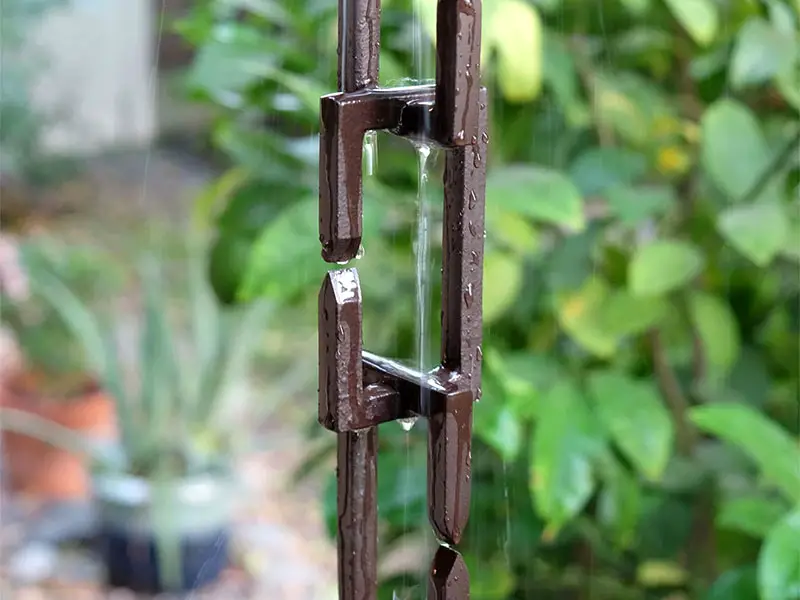
While you may have never heard of a rain chain, they are a popular alternative to gutters and are notable for their unique appearance. Rain chains allow water to be gently guided down while creating an aesthetically pleasing visual and sound experience.
These chains are available in various colors and materials using various materials to create durable structures that function as well as a typical rain gutter. Additionally, despite their complex appearance, their installation is quite simple.
Typically, rain chains come with an installation kit and can easily link to the existing gutter attachment on the house.
Rain chains require minimal maintenance and certainly no more than a usual gutter on a house. They have an outlet tube that makes for minimal cleanup, and the pot below catches all water that is expelled. These are a great option for someone looking for a style that is balanced with simplicity.
Pros:
- Unique and desirable appearance that adds a stylish element to the exterior of homes
- Minimal maintenance required
- Highly customizable and durable
Cons:
- They can be heavy and a bit bulky overall
Recommended:
- ADD STYLE AND HARMONY TO YOUR HOME. Make your home the envy of the neighborhood...
- THE SOOTHING SOUND OF RAIN. A rain gutter chain creates a peaceful calming sound...
- QUALITY ADVANTAGE. Your rain chains for downspouts are hand crafted in small...
2. Drip Edge
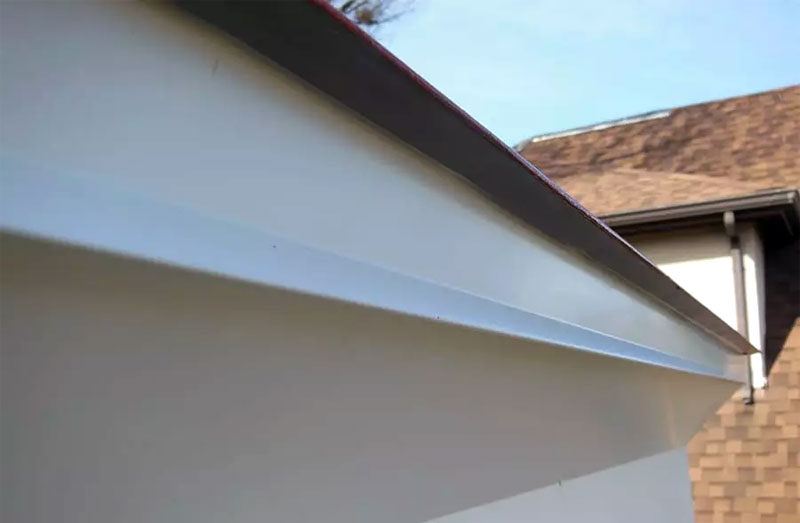
A drip edge or rain diverter is effectively explained by the name itself: an attachment at the edge of the house’s roof creates a barrier, which protects the house from water soaking into its surface. The drip edge is designed to collect water and allow it to glide down and off with minimal contact to the house itself.
This metallic attachment is not the single most aesthetically pleasing option, but it is certainly less noticeable overall than a gutter that juts out from the side of the house. Additionally, the installation is simple and not at all costly if you do rely on someone else to complete the task.
The primary concern with drip edges is simply their appropriate installation being critical to their effectiveness. Many find it inconvenient, but with drip edges enlisting the help of a professional is the only true way to ensure that you avoid water damage and keep the water from gathering at the base of your home and creating rot as traditional gutters have the tendency to do at times.
Pros:
- Less visible than a gutter on side of the home
- Simple and Affordable option
- Allows water to be removed without exposing the house to water damage
Cons:
- Perfect installation is required or they will not function
Recommended:
3. Hidden Gutters
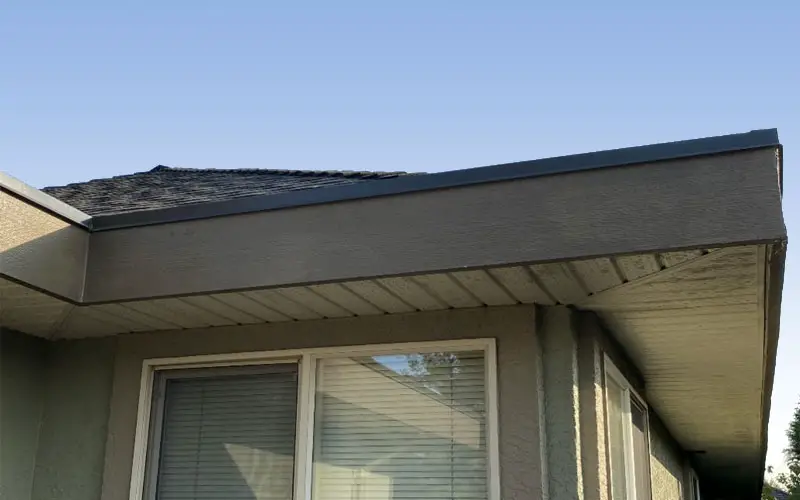
As the name indicates, hidden gutters are an ideal option for someone who wants the gutters out of sight or simply built-in to the structure of their house. If you are looking for an item with minimal impact on the outward appearance of your home, then this is a great option for you.
This option is a wonderful method to maintain the desired appearance of the exterior of your home without inflicting water damage. Additionally, they are customizable in their size, which makes them adequate for all locations regardless of rainfall.
However, these gutters can be unexpectedly hard to take care of because the out of sight, out of mind mentality can cause property-owners to neglect the usual maintenance due to forgetfulness. This can cause rot and leaks over time, which can increase their already relatively expensive cost.
Pros:
- Hidden from view—a great option for those concerned about the appearance of gutters
- Customizable size depending on the amount of average rainfall
- Built-in to home which increases their durability
Cons:
- Maintenance can be neglected if they are forgotten
4. Rain Dispersal System
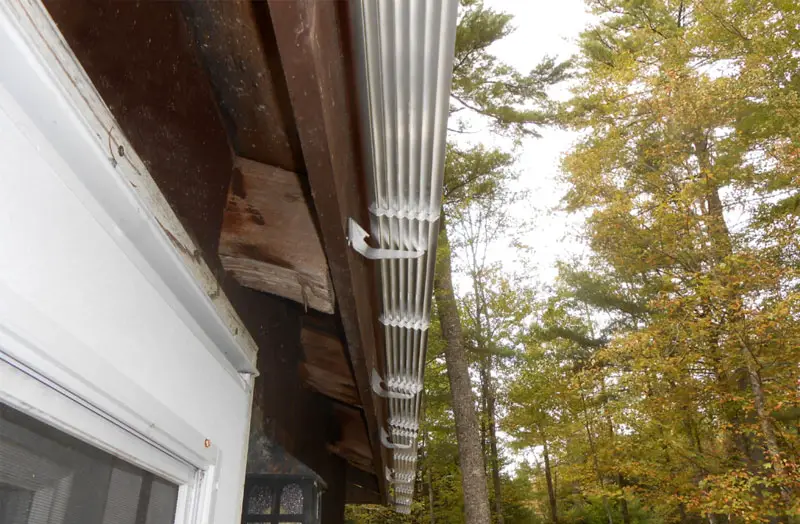
A rain dispersal system such as Rainhandler is another alternative mechanism to a gutter that can protect your home by diverting water from your foundation. They are made with intricate louver design features which enable airflow to prevent rot, while still protecting from water and other exterior elements.
Not only are rain dispersal systems highly customized and effective at preventing water exposure/damage, but they also protect from other large debris. One of the most common complaints about gutters is leaves and other large objects interfering with their functionality, with this system that is not an issue!
These are quite easy and affordable to install as well, which is yet another perk. However, they can be a bit tricky to customize depending on the shape of your rooftop and how level your house is. Be sure to consider this aspect before moving forward with this alternative.
Pros:
- Prevents rot due to consistent airflow
- Protects from larger debris such as leaves and stick
- Minimal maintenance in comparison to other options
Cons:
- Functionality depends on rooftop shape
Recommended:
- Rainhandler returns runoff back to rain size drops which fall naturally to the...
- Rainhandler - 5ft section comes with 3 brackets and 6 screws.
- Self cleaning by design means leaves and debris fall through slats or blow away
5. Ground Gutter
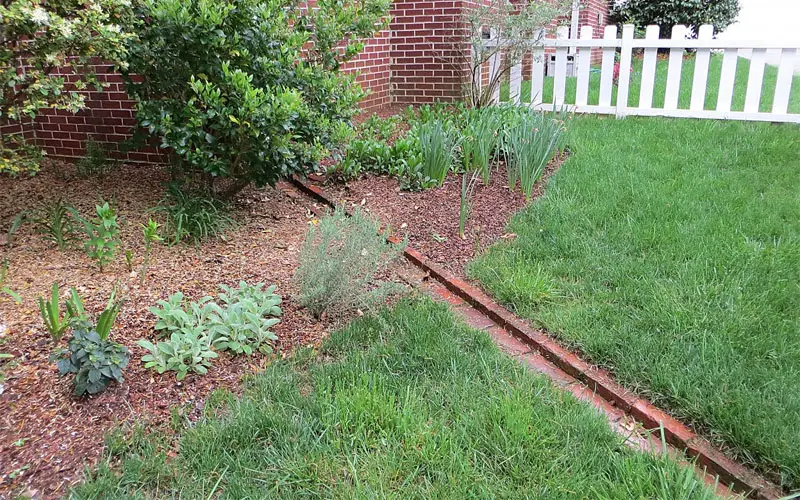
Although they sound similar to a traditional gutter, ground gutters actually have unique advantages to those looking to look outside the box. First and foremost, they are minimally visible, so they do not detract from the overall outward appearance of the home.
Being placed subtly at the bottom of the home makes them hardly noticeable, but still enables them to protect the base of the home effectively.
Additionally, these gutters are as easy to maintain as they are to install. They do not wear significantly over time and are a great pick for those looking for a durable alternative to gutters on houses.
However, while they are easy to install and uphold, they can be a bit more costly due to the materials that create their durability. Additionally, they require a trench to be dug to be effective which is an additional cost or, at the very least, quite a lot of work on the end of the installers.
Pros:
- Low to ground for minimal visual impact
- High-quality materials enhance their durability
- Protect the foundation of home from water damage
Cons:
- Expensive to install and maintain due to their materials
Read Also: 7 Sandbag Alternatives for Emergencies
6. Drip Path
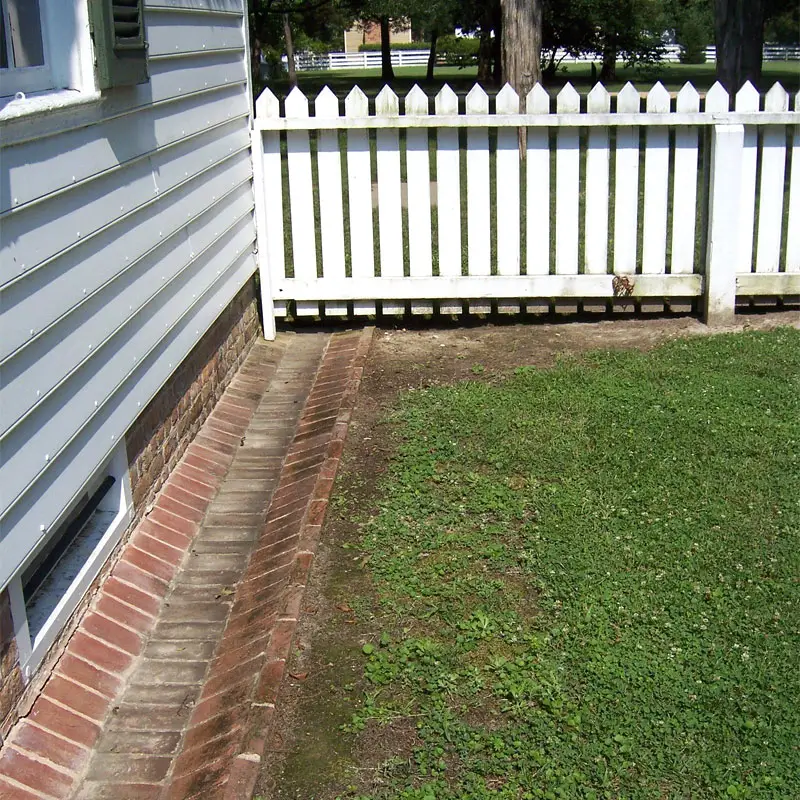
Drip paths rely on a slope to lead water running off the roof to stay far away from the roof itself and the base of the home. The drip path is installed at the base of the home on the ground, which makes it a great option for those worried about impacting the integrity of their home. Moreover, the path away from the roof allows you to protect your roof design overall.
A great way to picture this alternative to gutters is to reflect on the drip edge, but closer to ground level. This path redirects water in a similar mechanism but does most of the diverting closer to the ground unlike a drip edge, which does so on a roof. This offers flexibility if the layout of your roof is not as conducive to an alternative being installed on top.
However, this is not an ideal option if you do not have a suitable ground level for the slope needed. It can also risk damage to preexisting landscaping, which is important to consider if you have plants or other features outside the base of your home that are important to you.
Pros:
- A great alternative to drip-edge if your roof is not conducive to that
- Can be incorporated into the existing landscape design to maintain the appearance
- Sloped design protects home effectively
Cons:
- Rely on an adequate slope that ground level may not be able to provide without digging
- Can risk damage to existing landscape
7. Grading
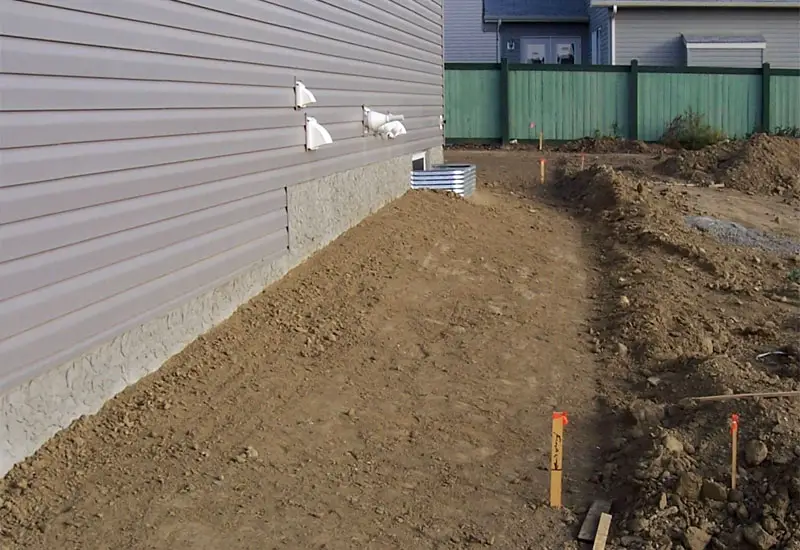
If you find that your biggest gripe with gutters is their risk of draining water too close to the house for your comfort, grading is a wonderful option for you that can move water redirection further away from the base of the home.
Grading is essentially a way to incorporate water drainage into your landscaping to move the water in a direction that is away from the house, rather than just down the side. Another bonus comes from the fact that this is another option that is pleasing in terms of appearance.
However, the installation on this method can be easier said than done as it involves altering your landscaping and risking exposure of other elements to water. Additionally, this may not be possible as an option for you if your home is unlevel or has other existing landscapes that cannot coexist with grading as such.
Pros:
- Can be incorporated in landscaping for a seamless appearance
- Moves water further from the house than traditional gutters
- Customizable/Flexible depending on your landscape
Cons:
- Can risk damage to existing landscape
FAQs
Here are some frequently asked questions about alternatives to gutters on houses.
Are gutters or gutter alternatives necessary for the home?
While some feel gutters do more harm than good and even advise against their installation, at the end of the day they are necessary. Fortunately, there are many solid alternatives as you have read that can help protect the roof and foundation of your home.
Particularly If you live in an area with high rain or snowfall the importance of gutters and their alternatives can not be overstated as they redirect rain from the home and protect the structural integrity of your house.
What types of maintenance do gutters and their alternatives require?
Maintenance of gutters and their alternatives is, unfortunately, a concept that is often overlooked at the expense of homeowners in the long run. Many types of gutters can become clogged and risk damage to the home or, at the very least, exhibit decreased functionality.
For many reasons, this is not ideal, so it is important to note what types of maintenance your gutters require.
If you are looking for options with less maintenance, it can be a great idea to consider one of the alternatives that is closer to ground level or incorporated into the landscape rather than attached to the side or top of the house itself.
Conclusion
In summary, if you find that gutters are not ideal for your situation, you should know that there are some viable alternatives. The above alternatives are curated to meet almost any need and can satisfy your water direction and protect your home just as a traditional gutter would.
As you have read, each option comes with its own unique installation method, costs, and benefits so be sure to consider what you have learned as you make the choice that is best for you.

